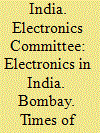| Srl | Item |
| 1 |
ID:
143513


|
|
|
|
|
| Publication |
London, Curzon Press Ltd., 1986.
|
| Description |
vii, 175p.pbk
|
| Series |
Studies on Asian topics; no, 9
|
| Standard Number |
0700701745
|
|
|
|
|
|
|
|
|
|
|
|
Copies: C:1/I:0,R:0,Q:0
Circulation
| Accession# | Call# | Current Location | Status | Policy | Location |
| 027534 | 951.058/ARE 027534 | Main | On Shelf | General | |
|
|
|
|
| 2 |
ID:
076906


|
|
|
|
|
| Publication |
2007.
|
| Summary/Abstract |
China has become the biggest exporter of electronic products in the world. Government policy intervention has contributed significantly to the rapid expansion of the electronics industry. The present paper examines the evolutionary development of industrial policies related to the electronics industry in China and the impacts of such policies on the shaping of the industry. In particular, the relationship between foreign funded enterprises and domestic firms are examined in detail. The future trend of the industry is also discussed in the paper, and the policy focus of the Chinese Government is predicted
|
|
|
|
|
|
|
|
|
|
|
|
|
|
|
|
| 3 |
ID:
027850


|
|
|
|
|
| Publication |
Bombay, Times of India press., 1966.
|
| Description |
287p.pbk
|
|
|
|
|
|
|
|
|
|
|
|
Copies: C:1/I:0,R:0,Q:0
Circulation
| Accession# | Call# | Current Location | Status | Policy | Location |
| 003715 | 621.380954/IND 003715 | Main | On Shelf | General | |
|
|
|
|
| 4 |
ID:
077670


|
|
|
|
|
| Publication |
2007.
|
| Summary/Abstract |
The failure of Japanese electronics firms to participate fully in the Internet-fueled growth of the global electronics industry during the late 1990s triggered a period of questioning among top executives. This article examines Japanese managerial responses to the organizational model "value chain modularity," which was deployed by the US electronics firms driving the creation of the Internet. While there were partial but significant steps taken in the direction of this new US model-increased specialization, outsourcing of low-end products, and shared factory investments in Japan -wholesale restructuring was resisted. This evidence is consistent with larger patterns of gradual institutional change in Japan . I argue that the result of this process will likely be increased, not diminished, institutional diversity over time. While globalization has accelerated the pace of change by opening new avenues for organizational experimentation and institutional layering, the drag on organizational change exerted by existing institutions slows the process enough to allow institutional and organizational innovations to develop into coherent systems with distinct characteristics. The result, inevitably, will be a uniquely Japanese approach to the challenges posed by globalization.
|
|
|
|
|
|
|
|
|
|
|
|
|
|
|
|
| 5 |
ID:
119915


|
|
|
|
|
| Publication |
2013.
|
| Summary/Abstract |
This paper contributes to the theory of subsidiary evolution in multinational corporations through utilising a value chain approach. It assesses the changing activities of the branches of Japanese electronics firms located in Southeast Asia (the ASEAN region) since the 1997-1998 financial crisis. In the paper, we argue that a modest development of Japanese subsidiaries has occurred in this region during the past 10 years or so. We connect models of subsidiary development to Michael Porter's value chain in the results of a set of interviews with 37 managers in the factories, sales offices and regional headquarters of Japanese subsidiary companies located in Singapore, Malaysia and Thailand. We show that decentralisation of management functions from Japan occurred in both primary and support activities of the value chain. However, corporate long-term research and development did not disperse to Southeast Asia and is unlikely to in the near future. The article interprets these results and highlights the need for further research relating to the evolving geography of Japanese electronics multinational corporations and their subsidiaries in Southeast Asia.
|
|
|
|
|
|
|
|
|
|
|
|
|
|
|
|